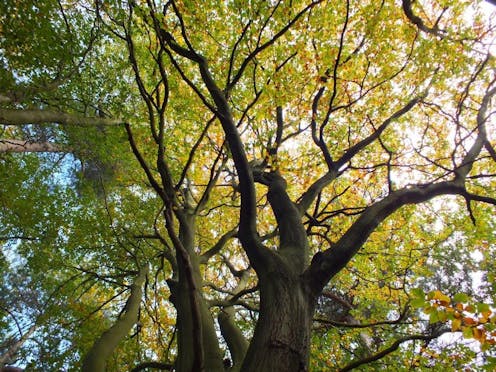
World leaders have been gathering at COP26, the UN climate summit in Glasgow, against a backdrop of flooded homes, closed roads and cancelled trains across the UK caused by extreme weather. These conditions are a stark reminder that as well as dramatically reducing our carbon emissions, we must also begin adapting to a climate that is already irreversibly changing.
Yet the UK’s third climate change risk assessment report warns of a growing “adaptation gap” between the risks the country faces and the action it’s taking, while the Environment Agency states bluntly that the UK must “adapt or die”.
A problem with climate adaptation is that conventional engineering solutions are rapidly becoming unaffordable and unsustainable. We can’t keep on building higher sea walls, extracting more groundwater from our land’s depleted resources to irrigate crops, or installing energy-guzzling air conditioning to fight heat.
Instead, nature-based solutions that reintegrate aspects of the natural world into our environment can help sustainably, affordably tackle the climate and biodiversity crises, while supporting local economies and improving people’s wellbeing.
For example, restoring saltmarshes can help protect communities at risk from coastal flooding and erosion, while providing vital habitats for wading birds.
Further inland, planting woodlands can help manage floods by intercepting rainfall, while restoring natural curves in artificially straightened rivers and recreating floodplain wetlands can slow floods. At Eddleston Water, a river valley in Scotland, these initiatives reduced flood peaks by 30%, protecting 500 properties downstream from damage.

Peatland degradation is another threat to landscapes. Healthy peatlands not only store vast amounts of carbon but also supply good-quality drinking water that requires little treatment. But when the peat dries out, it erodes into streams, turning the water brown.
On the Garron Plateau in Northern Ireland, peat degradation contaminated water supplies for 12,000 people. But reducing the number of grazing sheep on peatland and blocking drainage channels to keep peat wet allowed peatland mosses to regrow, cutting water treatment costs and lowering carbon emissions.
On farmland, techniques like adding more organic matter to soil can improve soil health and build resilience to pests, heatwaves, droughts and floods. And in urban areas, adding “green infrastructure” like parks and green roofs (roofs covered in vegetation) can help to cool cities and absorb water, preventing flooding in heavy rain.
Problems
Our research showed how governments could be missing opportunities to develop nature-based solutions. So in a recent review, commissioned by WWF and RSPB, we asked people working with nature-based solutions about the challenges they faced – to understand how we might better build these solutions into landscapes.

We found that, despite growing recognition of the role nature-based solutions can play in climate adaptation, policy support is lacking. For example, agroforestry (growing trees among crops or on grazing land) can protect livestock and crops in extreme weather. Yet it’s not covered by woodland planting grants and farmers aren’t trained in it, meaning that it’s rarely practised in the UK. And adding green walls and roofs to buildings, especially outside of London, also lacks widespread policy support – so these are rarely installed by developers.
We were surprised to find that some projects were struggling with regulations designed to control damaging activities, such as mineral extraction. Small charity-led projects trying to restore seagrass beds in coastal waters – to protect against floods and support fish – can face licensing fees of thousands of pounds from the Marine Management Organisation, even though they are only supporting the local ecosystem.
We also found that better standards are needed to make sure nature-based solutions provide their full benefits. Sustainable drainage systems are a key example. Good drainage systems consist of a connected network of ponds and wetlands, which capture and clean rainwater from urban areas before releasing it into the environment to avoid overloading sewers.

However, standards for sustainable drainage systems in England focus on the amount of rainwater collected, so many new drainage systems simply use underground tanks and pipes rather than creating pleasant outdoor spaces that help wildlife to thrive. New standards drafted by the Department for Environment, Food and Rural Affairs would bring England up to the high standards in place in Wales.
Similarly, when building developers are asked to boost sustainability by adding green roofs, the default option is often to unroll a cheap, thin, pre-grown vegetation mat that doesn’t offer much insulation and may not survive a dry summer.

In contrast, the Green Roof Organisation, a not-for-profit trade association, encourages planting a mix of wildflowers and including wildlife-friendly features such as logs or piles of stones. These thick, high-quality green roofs can cool buildings by as much as 20℃ and absorb up to half of the annual rainfall, while providing habitat for insects and birds.
Balancing act
It’s important to be careful when using techniques that could alter the balance of local ecosystems. For example, planting certain tree species in the “wrong place” can do more harm than good. Non-native tree species usually don’t help wildlife flourish. And trees can dry out carbon-rich soils, deplete local water supplies, or crowd out native grasslands and the species that depend on them.
Also, converting cropland to woodland in the UK will displace food production elsewhere, and could drive overseas deforestation to make space for new farmland: unless we free up space by eating less meat and cutting food waste.
To unlock the self-regulating power of our planet’s environment, nature-based solutions need to go mainstream. For that to happen, governments need to provide more funding and design more supportive policies along the lines we suggest in our review: helping people create resilient, healthy landscapes that dampen the effects of climate change.

This story is part of The Conversation’s coverage on COP26, the Glasgow climate conference, by experts from around the world.
Amid a rising tide of climate news and stories, The Conversation is here to clear the air and make sure you get information you can trust. More.
Alison Smith receives or has received funding from WWF-UK, RSPB, UKRI and the Oxford Martin School.
Alexandre Chausson receives funding from UKRI.
Nathalie Seddon receives funding from Natural Environment Research Council.
Did you find this post inspiring? Save THIS PIN to your board and check it later at any time!
